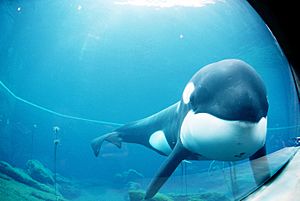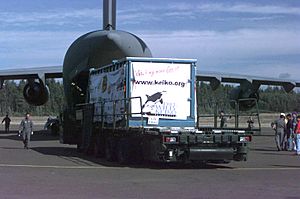Keiko (killer whale) facts for kids

Keiko on 1 December 1998, at the
Oregon Coast Aquarium |
|
| Species | Killer whale (Orcinus orca) |
|---|---|
| Breed | Icelandic |
| Sex | Male |
| Born | c. 1976 Near Iceland |
| Died | 12 December 2003 (aged 26–27) Arasvikfjord, Norway |
| Notable role | Willy in Free Willy |
| Weight | 6 tons (12,300 lb; 5440 kg) |
Keiko was a famous male killer whale (also known as an orca). He was born around 1976 near Iceland. In 1979, he was captured and lived in aquariums for many years. Keiko became very famous for playing Willy in the 1993 movie Free Willy. After the movie, people worked hard to release him back into the wild. He was set free in Iceland in 2002. Keiko died in Norway in December 2003 from a lung infection called pneumonia.
Contents
Keiko's Early Life
Keiko was caught near Reyðarfjörður, Iceland, in 1979 when he was about two years old. He was then sold to an aquarium in Hafnarfjörður, Iceland. At first, his name was Siggi, and later Kago.
In 1982, Keiko was sold to Marineland of Canada in Ontario, Canada. Here, he started performing for people. He also began to have skin problems, which showed he wasn't very healthy. Older killer whales sometimes picked on him too.
Keiko was sold again in 1985 to Reino Aventura, an amusement park in Mexico City. This park is now called Six Flags. In Mexico, he was given the name "Keiko." This is a Japanese name that means "lucky one." He was flown to Mexico in a cargo plane. At that time, he was only about 10 feet long. He lived in a tank that was really meant for smaller dolphins.
Becoming a Movie Star: Free Willy
Movie scouts found Keiko at the park in Mexico. He became the main star of the movie Free Willy in 1993. The movie was very popular. Because of this, the film studio, Warner Bros., wanted to find Keiko a better home.
Keiko was now 21 feet long. His pool in Mexico was only 22 feet deep, 65 feet wide, and 114 feet long. The water was often too warm for him. Some parts of the movie were filmed at Reino Aventura, and other parts were filmed in Mexico City.
The Free Willy-Keiko Foundation
After the movie, money from Warner Brothers and Craig McCaw helped start the Free Willy-Keiko Foundation in 1995. Many school children also sent donations. The foundation gave over $7 million to the Oregon Coast Aquarium in Newport, Oregon. This money was used to build new places for Keiko to get healthy. The goal was to eventually return him to the wild. Reino Aventura gave Keiko to the Foundation.
UPS helped move Keiko by ground to the nearby Newport Municipal Airport. He was in a special container. Before leaving Mexico, Keiko performed for the public one last time. He weighed about 7,700 pounds (3,493 kg). He was flown by air in a Lockheed C-130 Hercules plane loaned by UPS. During the flight, Keiko was in a 30-foot-long tank filled with cool seawater.
When Keiko arrived in Oregon in 1996, he moved into a new concrete pool. It held 2 million gallons of real seawater. This was the first time he had been in seawater. By June 1997, Keiko had gained a lot of weight. He weighed 9,620 pounds (4,364 kg).
Returning to the Wild
The idea of returning Keiko to the wild caused a lot of discussion. Some people thought he had been in captivity for too long to ever live in the wild again. Scientists later said that trying to return him to the wild wasn't fully successful. But they also said that tracking him helped make sure he was doing okay.
Others thought releasing him was a bad idea. A politician from Norway even said Keiko should be killed and his meat sent to Africa.
Even with the debates, the plan to prepare Keiko for the wild began. On September 9, 1998, he was flown to Klettsvík, a bay on an island in Iceland. When the plane landed, it had a problem, but Keiko was not hurt.
The Free Willy-Keiko Foundation and the Ocean Futures Society took care of Keiko every day. He first lived in a large pen in Klettsvik Bay. There, he learned skills to help him live in the wild. This included swimming in the open ocean with people watching him.
Ocean Futures left the project in late 2001. The Free Willy-Keiko Foundation and The Humane Society of the United States then took over managing the project until Keiko's death. Keiko was fully free by the summer of 2002. He left Icelandic waters in early August, following some wild killer whales. However, he did not join their group.
His journey was tracked using a special tag on his fin. About a month later, he arrived in Norway. He seemed to be looking for people and even let children ride on his back. His caretakers moved to Norway and continued to follow Keiko by boat for the next 15 months. Tests showed that Keiko had eaten during his 900-mile (1,500 km) trip from Iceland to Norway. Keiko sometimes went near groups of wild killer whales. But he always stayed far away, about 100–300 meters (109 to 328 yards) from them.
Death
Keiko died in Taknes Bay, Skålvikfjord, Norway, on December 12, 2003. He was about 27 years old. The likely cause of his death was pneumonia, a lung infection.
Was Releasing Keiko a Success?
Most people agree that the project to free Keiko was not a complete success. This is because he did not fully learn to live in the wild. In Norway, Keiko did not spend much time with other orcas. He also was not hunting for his own food. For months before he died, people had to feed him every day.
One report said that Keiko was not swimming freely in the fjord. Instead, his caretakers took him for "walks" in a small boat at least three times a week. It took more than 60 tries to get Keiko to join wild orcas. But he only followed one group when they were near a fishing boat. He then followed the boat into the fjords where he later died.
A scientific study said that Keiko was only seen diving with wild orcas once. After touching them, Keiko swam away and looked for human company on the tracking boat. The study confirmed he was never truly part of a wild group. He could not stop needing human contact. His return to humans for food and friendship showed that the project was not fully successful.
Reasons why Keiko might not have adapted include:
- He was very young when he was captured.
- He lived in captivity for a very long time.
- He did not have much contact with other killer whales.
- He had very strong bonds with humans.
However, David Phillips, who led the Free Willy-Keiko Foundation, said the project was a success. He said, "We took the hardest candidate and took him from near death in Mexico to swimming with wild whales in Norway." He added that Keiko had five years of experiencing natural seawater. Phillips believed it was a great success for Keiko's well-being. Others also said the release was a success. They said it gave him years of health and freedom.
The total cost to free Keiko was about US$20 million. The main author of the scientific study said that such a large amount of money might have been better spent on protecting whales and their homes. But he also noted that helping one whale is more exciting than general conservation.
Some experts suggest that for orcas who have lived in captivity for a long time, a "sanctuary" or "oceanic enclosure" might be a better idea. This is a large sea pen where they can live in natural water but still be cared for. This would improve their lives greatly, even if they can't be fully released.
Keiko's Movies and TV Shows
Keiko appeared in several movies and TV shows, often playing himself or the character Willy.
- Quinceañera (1987; TV series), as himself
- Keiko en peligro (1990), as himself
- Free Willy (1993), as Willy
- Free Willy 2: The Adventure Home (1995), as Willy
- Azul (1996; TV series), as himself
- Free Willy 3: The Rescue (1997), as Willy
- Keiko: The Untold Story (2010), as himself
- The Whale Who Would Not Be Freed (2013), as himself
See also
 In Spanish: Keiko (orca) para niños
In Spanish: Keiko (orca) para niños


